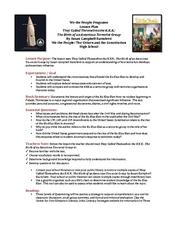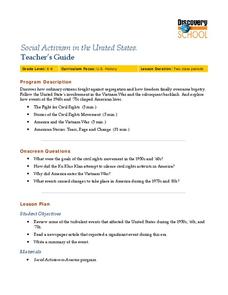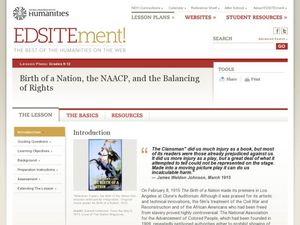Curated OER
Ku Klux Klan
Students discuss, write, and identify symbols of the activities of the Ku Klux Klan in the 1920's in Indiana. In this Ku Klux Klan lesson plan, students also take a field trip to view the Thomas Hart Benton Murals at Indiana University.
Curated OER
The Ku Klux Klan In Indiana: 1920-1930
Students examine the role of the Ku Klux Klan in Indiana from 1920-1930. They read an informational handout, define key vocabulary terms, conduct an interview with a parent or grandparent, write a family history, and role-play a scenario.
Alabama Department of Archives and History
Marketing a Bad Idea: Why So Many People Joined the Klan in the 1920s
How did the Klu Klux Klan manage to gain so many members during the 1920s? Class members examine Klan documents and promotional materials to gain an understanding of the propaganda techniques used to attract members.
Curated OER
USA: the KKK and Civil Rights Movement
Students view film footage of the Ku Klux Klan in the U.S. in the early 1920s and examine how the actions of the KKK have been viewed by different strands of the civil rights movement. They watch the film and answer discussion...
Curated OER
A Closer Look at the Klan
Fourth graders learn vocabulary, answer discussion questions, complete writing assignments, and identify symbols connected to the Ku Klux Klan. In this Ku Klux Klan lesson plan, 4th graders also go on a field trip to the Thomas Hart...
Curated OER
The Called Themselves the K.K.K.; The Birth of an American Terrorist Group
How did Ku Klux Klan develop and flourish in the US? How did the government respond to acts of terrorism conducted by the KKK following the Civil War? How does the government respond to acts of terrorism today? This resource launches a...
Curated OER
Social Activism in the United States
Seventh graders explore the goals of the Civil Rights Movement of the 1950s and 1960s. In this US History lesson, 7th graders read a newspaper article that reported a significant event during this era. Students write a summary of this...
Constitutional Rights Foundation
History of Immigration From the 1850s to the Present
The Statue of Liberty may embrace the huddled masses of the world, but has American society always joined in? After young historians read a passage about the history of American immigration in the 19th and 20th centuries, focusing on...
Curated OER
Birth of a Nation, the NAACP, and the Balancing of Rights
Eleventh graders analyze primary sources. In this US History lesson, 11th graders interpret written information. Students evaluate arguments and draw conclusions. Students develop and defend a position.
Alabama Department of Archives and History
"Scottsboro Boys": A Trial Which Defined an Age
Here's a must-have resource. Whether your focus is racism, the Great Depression, the "Scottsboro Boys" trial, or part of a reading of To Kill A Mockingbird, the information contained in the seven-page packet will save hours of research...
C-SPAN
1968: The Poor People's Campaign
The Poor People's Campaign of 1968 marked a shift in the civil rights movement to economic issues. Speakers in four C-SPAN video clips discuss different aspects of the campaign including Resurrection City, the Economic Bill of Rights,...
National Park Service
Teaching with Historic Places: Discover the Jackie Robinson Ballpark
Can sports and popular culture change public opinion? That's the essential question asked by a lesson plan that looks at the role Jackie Robinson's appearance at City Island Ballpark in Daytona Beach, Florida played in the desegregation...
Curated OER
History of Immigration From the 1850's to the Present
Eleventh graders study the history of immigration from 1850 to the present. In this American History lesson, 11th graders compare the 1924 and 1965 immigration acts and give a reasoned opinion on each. Students research, write, and...
Curated OER
Reporting on the 1920s
Use this roaring 1920s history lesson to have young writers research primary and secondary sources. They use their research to examine the events or famous public figures of the time period. Next, they imagine they're in the 1920s and...
PBS
The March on Washington and Its Impact
High schoolers read Martin Luther King, Jr's speech that he gave in Washington. They identify the social conditions that led to the civil rights movement. They discuss the significance of the March on Washington.
Curated OER
Nativist and Racist Movements in the U.S. and their Aftermath
Students examine the nativist and racist movements in the history of the United States. In groups, they analyze the reactions of religious and ethnic groups to these movements and create a chart to compare the goals of each group. To...
Curated OER
Living History - Civil War
Eighth graders, after researching antebellum North Carolina and the role of North Carolina in the Civil War, write, edit, publish, and produce their own plays.
Curated OER
The Roarding 20's
Tenth graders are introduced to the social, economic and political developments of the 1920s. Using historical developments that are part of the indicator, they create a three-dimensional graphic organizer.
Curated OER
City Desk with Malcolm X
High schoolers view a film about civil rights and the role Malcolm X played in the civil rights movement. They create a timeling about the events that occured from segregation to integration. They discuss discrimination as well.
Curated OER
Jazz in America Lesson Plan 5
Students survey Bebop and identify the basic terms associated with jazz.They experience the music of Charlie Parker and Billie Holiday and participate in a class discussion regarding jazz's contribution to and reflection of American...
National Park Service
Civil War to Civil Rights: From Pea Ridge to Central High
Explore how the Civil War impacted the Civil Rights Movement. Class members complete a series of projects for a unit that uses a layered curriculum approach to learning.
Curated OER
What Caused the Great Depression?
Analyze the many causes of major political, economic, and social developments during the 1920s and 1930s, with emphasis on the Great Depression. Read photographs from the 1920's and the 1930's, then write a brief explanation of what you...
Curated OER
Human Rights/Civil Rights
Students connect their examination of the novel Roll of Thunder, Hear My Cry to a historical and contemporary study of the issue of human rights and civil rights by creating a HyperStudio stack.
Curated OER
Social Activism In The United States
Students explore justice issues. In this social activism lesson, students watch "Social Activism in the United States," and then locate newspaper articles from the 1960's and 1970's about events during the era.

























